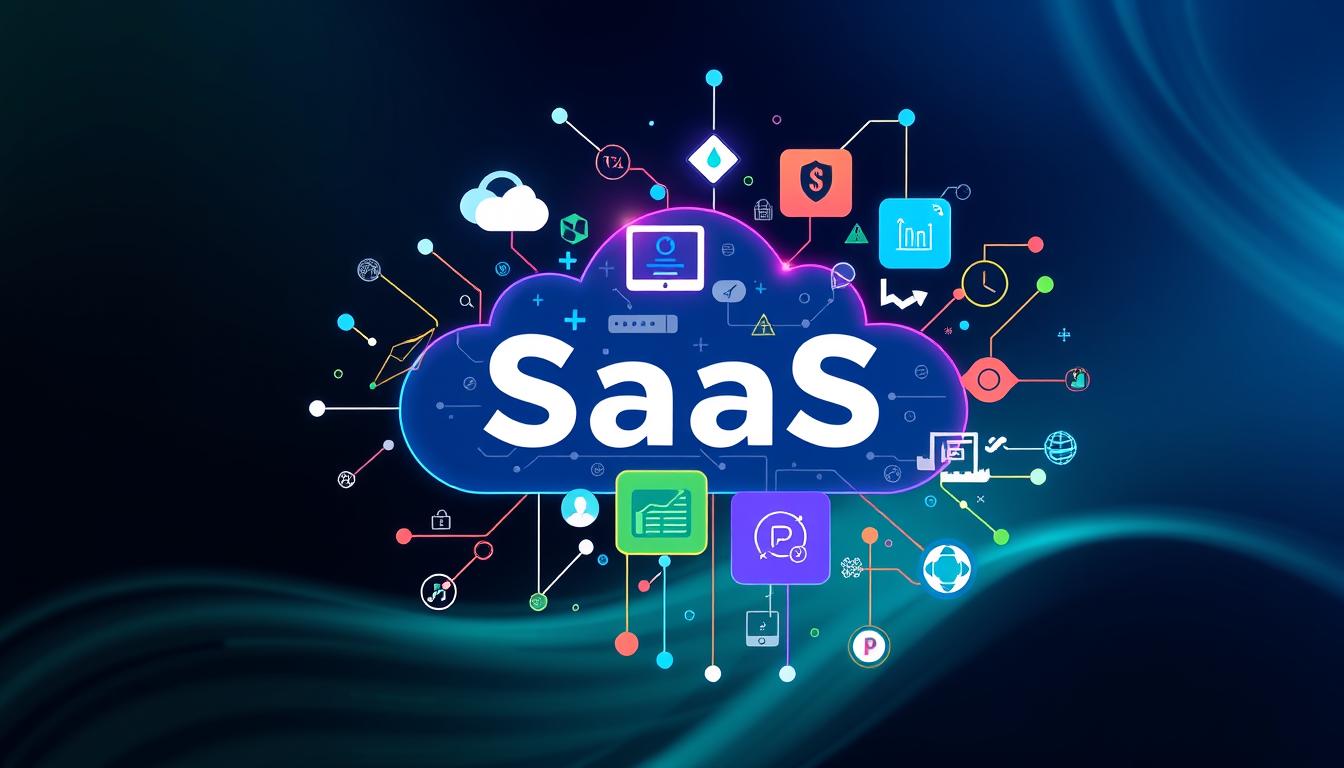The software as a service (SaaS) industry is witnessing a significant transformation. Mergers and acquisitions (M&A) are playing a crucial role in reshaping the market. They drive innovation and expand business horizons, even in uncertain economic times. The middle-market SaaS sector is particularly vibrant, with an uptick in transactions. This reflects robust market activity, fueled by strategic opportunities and innovative partnerships.
Recent statistics show M&A activity in this sector is thriving. This shift indicates a move towards deeper market consolidation. SEG played a key role in advising ten B2B SaaS companies on significant transactions. This highlights the importance of industry consolidation trends. Mergers, like ClearPathGPS’s acquisition by GPS Insight, reveal the potential for growth and new capabilities in various sectors, including fleet management.
This wave of consolidation is not just about numbers. It’s about thriving through collaborations and strategic alliances. These partnerships provide end-to-end solutions, especially through vertical integration. Companies like Actionstep and Soluno demonstrate how consolidation can lead to market expansion and innovation. As industries adapt to rapidly changing consumer expectations, this trend becomes even more significant.
Key Takeaways
- SaaS M&A transactions indicate vibrant market activity.
- Strategic opportunities drive industry consolidation trends.
- Partnerships foster growth in various sectors.
- Vertical integration delivers end-to-end solutions.
- An increasing number of companies pursue M&A for market expansion.
Understanding SaaS Consolidation
Exploring understanding SaaS consolidation uncovers its critical role in today’s digital world. It’s about merging or acquiring other companies to boost market share, refine services, and strengthen competitive edge. The SaaS market overview shows a remarkable surge, with cloud service spending expected to hit $679 billion by 2024.

This shift aids businesses in streamlining operations and improving product value for users. The SaaS market is set to grow at a 19.19% compound annual growth rate (CAGR) from 2022 to 2027. This growth reflects investors’ confidence and the rising need for cloud-based solutions.
Recent SaaS M&A trends show a move towards consolidation to manage costs. The BetterCloud 2024 State of SaaSOps report points out that growth has slowed due to tech stack consolidations. It notes that 53% of licenses are unused, prompting a reevaluation of software subscriptions and their management.
- Consolidating tech stacks helps companies significantly reduce IT spending.
- Standardizing tools boosts workforce efficiency, reducing training and support needs.
- Consolidation enhances security by simplifying management and reducing vulnerabilities.
Businesses are advised to perform regular SaaS audits to spot unused tools and overlapping functions. By assessing user needs and app usage, companies can ensure they fulfill all requirements. Amidst economic uncertainty, focusing on tech-stack consolidation is seen as a strategic move to boost profitability and operational efficiency.
Factors Driving SaaS Industry Consolidation
The SaaS landscape is undergoing significant transformations, driven by various factors driving SaaS industry consolidation. Companies aim to expand their market presence by merging with or acquiring others. This approach enables the integration of technologies and the creation of all-encompassing solutions that meet evolving customer needs.
The relentless saas market pressures push organizations to innovate ceaselessly. With an average of 371 SaaS applications per company in 2023, the need for streamlined processes is evident. Many SaaS firms spend too much time on manual planning and budgeting, highlighting the potential for improvement through consolidation.
Investing in new technologies is a top priority for SaaS buyers, aiming to boost productivity and enhance security. In 2024, 60% of businesses plan to increase their software spending, highlighting the growing demand for integrated solutions. This demand fuels consolidation catalysts in SaaS as companies strive to meet these needs more efficiently.

The global SaaS market is experiencing rapid growth, expected to reach $317.55 billion by 2024. This growth emphasizes the need for operational efficiencies that strategic mergers can provide. As companies compete to stay ahead, consolidation is set to remain a prevalent strategy in the industry.
SaaS Consolidation Trends
The SaaS landscape is rapidly evolving, with several trends emerging in the consolidation movement. Companies are working to improve their services and market positions. Recent M&A activity shows a competitive environment driven by innovation and strategic alignment.
Recent M&A Activity in the SaaS Market
The number of mergers and acquisitions in the SaaS sector has increased, attracting both investors and companies. Notable mergers aim to enhance product portfolios and expand market reach. These trends highlight a significant shift, driven by the need to capture emerging technologies and stay relevant in a crowded market.
The Data-as-a-Service (DaaS) market is expected to grow by 28.64% in 2023. This growth reflects the thriving nature of the sector.
Key Drivers of Market Consolidation
Several factors are driving market consolidation in the SaaS industry. The rise in B2B buyers’ preference for third-party marketplaces, from 22% in 2021 to 28% in 2022, is a key factor. Companies are adapting to meet these changing purchasing behaviors.
Streamlined SaaS spend management is now crucial, with cloud management platform traffic increasing by 438% in two years. The integration of AI in product development has also enabled quicker responses to customer needs. These factors are driving consolidation efforts.
Emerging SaaS Consolidation Patterns
The SaaS industry is undergoing a significant transformation, driven by emerging SaaS consolidation patterns. A key trend is vertical integration, enabling companies to offer comprehensive solutions that boost operational efficiency. The shift towards cloud-based programs, now at 70%, marks a major change in how businesses operate.
By 2025, 85% of corporate applications are expected to be SaaS-based, indicating a bright SaaS market future. Companies are focusing on niche markets, developing specialized solutions to gain a competitive edge. This approach not only fuels innovation but also builds stronger customer loyalty.
The global SaaS market, valued at USD 253.62 billion in 2023, is set to reach USD 282 billion in 2024. It’s projected to hit USD 374.50 billion by 2028, showing a 500% increase in seven years. The United States, with its abundance of SaaS companies, is a major driver of this growth.
Exploring industry patterns further, we see a rapid uptake of new technologies. SaaS adoption is not just about streamlining operations but also about embracing innovations that boost revenue. This trend places SaaS products at the heart of business strategies, setting the stage for a vibrant market.
The Impact of M&A on the SaaS Industry
The SaaS industry is undergoing significant changes due to rising merger and acquisition (M&A) activities. These transactions are reshaping the market and enhancing customer experience. By combining different technologies and resources, companies create more comprehensive solutions. This meets a wider range of consumer needs.
Changes in Market Dynamics
In the second quarter of 2023, 538 SaaS deals were completed, a 5% drop from the previous quarter. This reflects a shift towards more efficient and targeted acquisitions. Vertical-focused SaaS businesses were especially sought after, making up 46% of M&A deals. This trend shows investors are looking for specialized solutions to meet customer demands.
Customer Experience Enhancements
M&A activities lead to operational streamlining and improved customer experience in SaaS. By integrating various products, companies offer more reliable solutions. This results in higher customer satisfaction and retention rates. The landscape is evolving, with software deals making up 70.3% of the top ten deals in H1 ’24. This indicates that stronger entities are emerging to better serve client needs.
IT Consolidation Strategies Employed by SaaS Companies
The SaaS industry is rapidly evolving, with a market valuation projected to reach $908.21 billion by 2030. To remain competitive, companies are adopting robust IT consolidation strategies. These strategies streamline operations, enhance profitability, and improve agility in response to market demands.
Outsourcing non-core functions is an effective approach. By delegating tasks to specialized providers, SaaS companies can focus on their core competencies. This leads to improved efficiency and quick adaptation to changing circumstances.
Automation is key in these strategies. It reduces operational costs and minimizes manual workload. This frees up teams for more strategic activities, promoting a collaborative work environment.
Consolidation tactics, like integrating IT resources across platforms, are crucial. A well-integrated IT infrastructure ensures data flows seamlessly between departments. This improves service delivery and customer satisfaction. With nearly half of the world’s data expected to be stored in the cloud by 2025, effective consolidation will become even more critical.
By leveraging these strategies, SaaS companies can address compliance regulations, enhance cybersecurity, and align with evolving customer preferences. The ability to implement these strategies effectively will define the success of leading SaaS providers as the industry moves forward.
Strategic Partnerships and Alliances
Strategic partnerships in SaaS are revolutionizing how companies interact and grow. These collaborations boost service offerings and expand market reach. Exploring case studies of SaaS mergers offers insights into their operational significance and benefits.
Case Study: GPS Insight and ClearPathGPS
The merger between GPS Insight and ClearPathGPS showcases the strength of strategic alliances in fleet management. By combining their services, they offered a more comprehensive solution to customers. This partnership demonstrates how SaaS alliances can improve product offerings and customer satisfaction.
Case Study: Actionstep Acquiring Soluno
Actionstep’s acquisition of Soluno highlights adapting to industry changes. The merger aligned strategic goals and leveraged shared technology, enhancing their competitive edge in legal software. Such examples illustrate how alliances drive growth and innovation in the sector.

As the SaaS industry expands, focusing on partnerships will boost your offerings and market presence. The emphasis on customer success and shared strategies will likely reshape SaaS collaborations in the future.
To gain a deeper understanding of cloud service dynamics, explore cloud computing trends affecting strategic alliances today.
Market Consolidation: New Market Entry Strategies
In the fast-paced SaaS world, companies are always on the lookout for new ways to grow. Market consolidation strategies are key to entering new markets. One effective method is using mergers and acquisitions. This approach helps companies expand their reach while streamlining resources and integrating technology.
Example: Ideagen and Tritan Acquisition
The acquisition of Tritan by Ideagen is a great example of successful SaaS strategies for entering new markets. This move boosts Ideagen’s presence in the maritime software sector. It allows the company to expand its services and tap into new, profitable markets. By merging with Tritan, Ideagen highlights the power of consolidation in expanding its influence and leveraging new technologies.
Looking ahead, the importance of developing strong market consolidation strategies will increase. With the SaaS market expected to hit over $200 billion by 2024, your ability to adapt and navigate these shifts will be crucial for your business’s success.

The Role of Technology in SaaS Mergers
The SaaS industry is witnessing a profound transformation, driven by the integration of advanced technology. In mergers, technology in SaaS mergers stands out as a key focus. This integration allows companies to deliver more comprehensive services, catering to the varied needs of their customers.
End-to-End Solutions Through Vertical Integration
Vertical integration is crucial in developing end-to-end solutions in SaaS. It combines different services and technologies, creating platforms that simplify user experience and boost customer satisfaction. This strategy tackles fragmentation, enabling users to access all necessary tools in one place.
The trend towards integrated solutions is highlighted by the SaaS market’s projected growth to $908 billion by 2030. Currently, 71% of businesses use SaaS, with forecasts suggesting 85% of applications will be SaaS-based by 2026. These figures underscore the industry’s move towards consolidation and integration.
With 44% of businesses now using AI, the need for technology that boosts efficiency and innovation is clear. This is critical, given that 9% of working hours are lost switching between applications. Companies like Nudge Security lead by offering comprehensive functionalities that help optimize software inventory, improve security, and ensure operational efficiency.

Moreover, cybersecurity has become a top priority as businesses fight off potential breaches. Companies that leverage vertical integration will not only improve their services but also build robust platforms that adapt to market changes. The rise of products from non-tech professionals signals a shift, suggesting future innovations will come from diverse fields. This broadens the scope and capabilities of technology in SaaS mergers.
As the industry advances, the focus on creating integrated, user-friendly solutions will grow. This will position organizations for long-term success in a competitive market.
Future Predictions for SaaS Market Consolidation
The SaaS market is on the cusp of a significant transformation. By the end of 2024, it’s expected to grow to over $230 billion. Analysts predict a compound annual growth rate (CAGR) of 18.7%, aiming for a market value of over $900 billion by 2030. This growth is fueled by advancing technologies and evolving business demands.
Today, organizations rely heavily on SaaS solutions, with an average of over 110 apps used. The shift to remote work, affecting over 4.7 million in the U.S., emphasizes the need for flexibility. By 2025, it’s predicted that 85% of global organizations will adopt cloud-based applications.

Significant figures highlight this evolution. More than half of SaaS providers are based in the USA. Vertical SaaS solutions are gaining attention for addressing specific industry challenges. Emerging trends, like Data-as-a-Service (DaaS), show a focus on innovative offerings.
The rise of generative AI in SaaS underscores the importance of operational efficiency and customer satisfaction. Major players like Salesforce and Microsoft are set to implement these technologies in 2024. This could lead to a shift in pricing models, making costs more aligned with actual use.
The SaaS landscape is set for continued consolidation. Companies are adapting to increase their market share and profitability. Staying updated on these trends is crucial for those involved in the SaaS ecosystem. For more on optimizing your business operations, explore strategies for effective onboarding and training.
Conclusion
The SaaS industry is undergoing a significant transformation, driven by ongoing consolidation. Recent mergers, such as Salesforce acquiring Slack for $27.7 billion, and InvestCloud acquiring Advicent Solutions, are crucial for innovation and expansion. This wave of consolidation is not just a response to the complexity of multi-SaaS environments. It’s also a strategic move to optimize resources and mitigate SaaS sprawl.
As we look ahead, understanding the trends from these consolidations is essential. The trend towards comprehensive SaaS management platforms and increased investment from both domestic and global sources points to robust growth. With $207.39 billion in venture capital backing this year, the SaaS sector is poised for a strong recovery and innovative expansion.
The future of the SaaS industry will be shaped by those who embrace strategic partnerships and adopt emerging technologies like AI and machine learning. Companies focusing on user experience, security, and automated solutions will thrive. They will redefine success in this ever-evolving market.
FAQ
What is SaaS consolidation?
What factors are driving SaaS industry consolidation?
How does M&A affect the SaaS industry?
What are the emerging patterns in SaaS consolidation?
What IT consolidation strategies are commonly utilized by SaaS companies?
Can you provide examples of strategic partnerships in the SaaS industry?
What role does technology play in SaaS mergers?
What are the future predictions for SaaS market consolidation?
Source Links
- 10 Recent SaaS M&A Transactions: Insights and Trends for SaaS Operators – https://softwareequity.com/blog/saas-ma-transactions
- 9 Saas Trends And Predictions For 2024 | Deduxer – https://deduxer.studio/blog/9-saas-trends-and-predictions-for-2024-deduxer
- The State of Government SaaS M&A: Trends Driving Growth and Deal Activity in 2024 – https://softwareequity.com/blog/government-saas-trends
- Top 13 SaaS Trends That Will Disrupt 2024 & The Future – https://www.rib-software.com/en/blogs/saas-trends
- State of SaaSOps 2024: Consolidation is the new IT mantra – https://www.bettercloud.com/monitor/state-of-saasops-2024-consolidation-is-the-new-it-mantra/
- How Tech-Stack Consolidation is Redefining B2B SaaS – https://pipeline.zoominfo.com/sales/how-tech-stack-consolidation-is-redefining-b2b-saas
- 74 SaaS Statistics, Trends and Benchmarks for 2024 | Vena – https://www.venasolutions.com/blog/saas-statistics
- SaaS Industry Trends | GlowTouch – https://www.glowtouch.com/saas-software-industry-trends/
- 12 SaaS Trends for 2024 That Work Today – https://blog.payproglobal.com/saas-trends
- Top SaaS Trends: Stay Ahead with Ortto’s Insights – https://ortto.com/learn/saas-trends/
- Discover the 2024 State of SaaS Consolidation trends | Productiv – https://productiv.com/state-of-saas/2024-saas-trends-consolidation/
- Emerging SaaS Trends 2024 & Beyond. 🚀 – https://medium.com/quick-code/emerging-saas-trends-2023-beyond-b45806d85a93
- Discover the 2024 State of SaaS Usage trends from Productiv – https://productiv.com/state-of-saas/2024-saas-trends-usage/
- 50+ Key SaaS Statistics To Know In Under 15 Minutes (2024) – https://www.cloudzero.com/blog/saas-statistics/
- SaaS M&A volumes on course for second-highest total in 10 years – https://finerva.com/news/saas-ma-volumes-on-course-for-second-highest-total-in-10-years/
- PDF – https://frostbrowntodd.com/app/uploads/2023/05/Software-Industry-MA-Trends-2022_2023.pdf
- Global M&A trends in technology, media and telecommunications: 2024 mid-year outlook – https://www.pwc.com/gx/en/services/deals/trends/telecommunications-media-technology.html
- The Future of SaaS: Top Trends and Predictions in 2024 and Beyond – https://medium.com/@tobitobe/the-future-of-saas-top-trends-and-predictions-in-2024-and-beyond-a938c92b059b
- How SaaS companies are navigating a challenging market – https://www.zuora.com/resource/how-saas-companies-are-navigating-a-challenging-market/
- Evolution of SaaS alliance partnerships – https://www.linkedin.com/pulse/evolution-saas-alliance-partnerships-evthe
- Canalys Resources – SaaS businesses are unlocking growth through diversified partner ecosystems – https://canalys.com/resources/saas-businesses-are-unlocking-growth-through-diversified-partner-ecosystems
- 16 Market-Defining SaaS Trends for 2023-2025 – https://sumatosoft.com/blog/15-market-defining-saas-trends
- Top 10 SaaS Trends for 2024 – https://www.bayleafdigital.com/top-10-saas-trends-for-2024-what-to-look-for/
- New Trends in the Service as a System (SaaS) Tech Industry to Sustain its Dynamic Growth – https://thebusinessmanual-onemega.com/news/new-trends-in-the-service-as-a-system-saas-tech-industry-to-sustain-its-dynamic-growth/
- How SaaS discovery is useful in a merger or acquisition – https://www.nudgesecurity.com/post/how-nudge-security-is-useful-in-a-merger-acquisition
- Technology Stack in Due Diligence for SaaS M&A (4 of 8) – https://www.linkedin.com/pulse/technology-stack-due-diligence-saas-ma-extensive-4-8-dave-westlake-wtmic
- SaaS Market Growth and Biggest Trends in 2024 | MADX – https://www.madx.digital/learn/saas-market
- The SaaS market size: trends and predictions – https://euroweeklynews.com/2024/05/31/the-saas-market-size-trends-and-predictions/
- Enterprising Insights: Episode 8 – Predictions for 2024 in the Enterprise Software Market – https://futurumgroup.com/insights/enterprising-insights-episode-8-predictions-for-2024-in-the-enterprise-software-market/
- Unlock Savings and Innovation: Mastering SaaS Consolidation Strategies – https://saasrooms.com/saas-spend-management-blog/mastering-saas-consolidation-strategies/
- The State of SaaS Management: Trends and Challenges ·Our Blog – https://www.getboza.io/blog/the-state-of-saas-management-trends-and-challenges
- SaaS Industry Report 2024: A Comprehensive Overview – https://www.omnius.so/blog/saas-industry-report-2024


